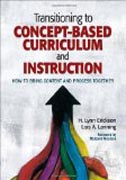
Transitioning to Concept-Based Curriculum and Instruction
Erickson, H. Lynn
Lanning, Lois A.
This accessible guide is a must-have for teachers, curriculum designers, and school leaders, providing them with everything they need to know about developing curriculum and instruction for the K-12 classroom. takes a unique approach to the topic of curriculum development by bringing together Lynn Erikson’s Structure of Knowledge and Lois Lanning’s Structure of Process to help educators create Common Core-aligned, concept-based curriculum across subject areas and grade-levels. INDICE: List of Figures and TablesForeword by Malcolm NicolsonAcknowledgmentsAbout the AuthorsIntroduction Purpose of the Book Audiences Chapter OverviewChapter 1. Curriculum Design: From an Objectives-Based to a Concept-Based Model A Short Retrospective, From the Authors, on Educational Swings The Value of Know, Understand, and Able to Do in Concept-Based Models Problems With Traditional Content Objectives Discussion Questions SummaryChapter 2. Two-Dimensional Versus Three-Dimensional Curriculum Models Contrasting the Two-Dimensional and Three-Dimensional Models Introducing the Structures of Knowledge and Process The Interplay of Process and Knowledge Contrasting Instructional Descriptions Discussion Questions SummaryChapter 3. The Structure of Knowledge Understanding the Relationships in the Structure of Knowledge How the Structure of Knowledge Guides Curriculum Design Designing Disciplinary Curriculum Frameworks at the National, State, or Local Levels Mathematics as a Concept-Driven Discipline Examples of Concepts and Subject-Specific Generalizations Discussion Questions SummaryChapter 4. The Structure of Process The Structure of Process How the Structure of Process Guides Curriculum and Instruction Discussion Questions SummaryChapter 5. The Developing Concept-Based Teacher Bridging the Gaps Between Knowing, Doing, and Understanding Collaborative Concept-Based Lesson Planning Common Terminology Used to Describe Quality Instruction The Developing Concept-Based Teacher Do The Developing Concept-Based Teacher Rubrics Have a Place in Teacher Evaluation Plans? Discussion Questions SummaryChapter 6. The Developing Concept-Based Student What About Thinking? The Relationship Between Critical Thinking and Concept-Based Teaching and Learning Developing Critical Thinking The Developing Concept-Based Student Why These Categories? Discussion Questions SummaryChapter 7. What Do Teachers Need to Understand About Concept-Based Pedagogy? The What and Why of Concept-Based Curriculum and Instruction The How of Concept-Based Curriculum and Instruction Four Critical Aspects of Concept-Based Pedagogy Quality Pedagogy Concept-Based Classrooms Discussion Questions SummaryChapter 8. What Do Principals and Instructional Coaches Need to Understand? Implementing and Sustaining Concept-Based Curricular and Instructional Models in Schools Setting the Stage for Curriculum Implementation Staff Development Staff Support With Accountability: Building System-Wide Synergy The Collection and Analysis of the Right Data Discussion Questions SummaryChapter 9. What Do District Leaders Need to Understand About Concept-Based Curriculum Designs? District Leaders Discuss Concept-Based Curriculum and Instruction Discussion Questions SummaryChapter 10. Summary and the Road Ahead Curriculum and Instruction: The Warp Concept-Based Learning: The Weft The Path Forward Discussion QuestionsResources Resource A. Concept-Based Mathematics Unit Resource B. Concept-Based Science Unit Resource C. Concept-Based Art Unit Resource D. Concept-Based World Language Unit Resource E. Concept-Based Music Unit Resource F. Adapted Learning Activities for Chapter 7ReferencesIndex
- ISBN: 978-1-4522-9019-5
- Editorial: Corwin
- Encuadernacion: Rústica
- Páginas: 224
- Fecha Publicación: 18/02/2014
- Nº Volúmenes: 1
- Idioma:
